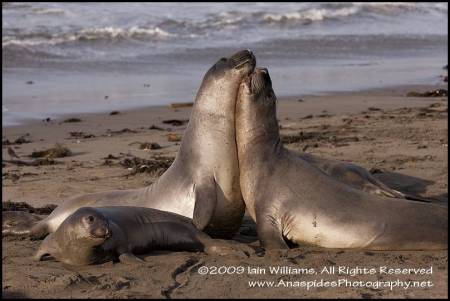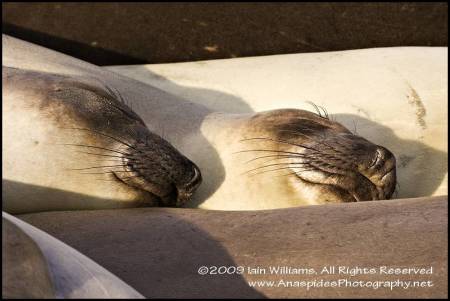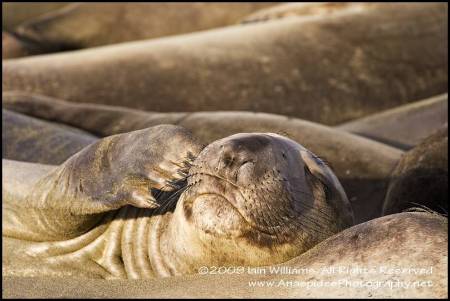Northern Elephant Seals, California
 Saturday, February 6, 2010 at 5:05PM
Saturday, February 6, 2010 at 5:05PM  I have always been fascinated of Elephant Seals and welcome any opportunity to observe them in their natural habitat. This is the second time I have visited this seal haul out and as with other visits I wasn’t disappointed. The first visit was in January when the seals were well into their breeding cycle and the bull seals were fighting other rival bull seals for mating rights. During this time the haul out area was in constant flux with seals everywhere doing seal things.
I have always been fascinated of Elephant Seals and welcome any opportunity to observe them in their natural habitat. This is the second time I have visited this seal haul out and as with other visits I wasn’t disappointed. The first visit was in January when the seals were well into their breeding cycle and the bull seals were fighting other rival bull seals for mating rights. During this time the haul out area was in constant flux with seals everywhere doing seal things.
LEFT: Northern Elephant Seals practice fighting while juvenile look on carefully.
 This visit was in early November and there wasn’t nearly as much “action” as during the breeding season. Females were lolling about catching the rays and sleep appeared to be high on the agenda of many of the seals. Although there was some fighting, most of the bulls were adolescent males under 5 years of age gaining their training teeth; the season was too early for any “real” fighting to take place as the Alpha males had yet to visit the haul out to claim mating privileges.
This visit was in early November and there wasn’t nearly as much “action” as during the breeding season. Females were lolling about catching the rays and sleep appeared to be high on the agenda of many of the seals. Although there was some fighting, most of the bulls were adolescent males under 5 years of age gaining their training teeth; the season was too early for any “real” fighting to take place as the Alpha males had yet to visit the haul out to claim mating privileges.
LEFT: Female Northern Elephant Seals sleep in early morning sun.
 I arrived on site just after dusk and did a quick reconnoiter of the site to determine the best shooting positions and angles for the following morning. The following day was an early wake up as I wanted to be on-site and ready to shoot as the first rays broke the horizon. I always like spending time with animals in the early morning; the air is usually crisp and the animals are interesting to watch as they transition from sleeping to being more active. Also, the early morning usually provides ideal photographic opportunities with soft golden light.
I arrived on site just after dusk and did a quick reconnoiter of the site to determine the best shooting positions and angles for the following morning. The following day was an early wake up as I wanted to be on-site and ready to shoot as the first rays broke the horizon. I always like spending time with animals in the early morning; the air is usually crisp and the animals are interesting to watch as they transition from sleeping to being more active. Also, the early morning usually provides ideal photographic opportunities with soft golden light.
LEFT: Adolescent Northern Elephant Seal scratches whiskers.
Seals, especially females and pups, seem to engender what most people fall in love with; the big round eyes and the slight tilt of the head all suggest a loveable and benign creature that just beckons to be petted. Indeed, there has been more than one incidence of well-meaning people collecting seal pups and taking them home in backpacks! What these people were thinking at the time is beyond me; a seal pup does not eat puppy dog food! However, like any wild creature seals deserve respect. If you approach too closely they will try and bite you, and I’ve observed instances when a seal has chased a person at an alarming fast rate across the beach. Therefore, when photographing seals, especially elephant seals that do not tolerate closeness, it’s normally a good idea to use a longer focal length lens such as a 300mm or 500mm lens.
GENERAL INFORMATION
Elephant seals take their name from the large proboscis of the adult males (bulls), which resembles an elephant's trunk. The bull's proboscis is used in producing extraordinarily loud roaring noises, especially during the mating season. More importantly, the nose acts as a sort of rebreather, filled with cavities designed to reabsorb moisture from the animal’s exhalations. This is important during the mating season when the male seals rarely leave the beach to feed and therefore must conserve body moisture, as they have no incoming source of water.
The seals can spend upwards of 80 percent of their lives in the ocean and can hold their breath longer than 120 minutes – well over any other marine mammal (excluding whales). The depth these seals dive to is very impressive and seals have been recorded at 2000 feet searching for their favorite prey which is stingray, octopus, squid, small sharks, eels, and in the southern ocean, penguins. While excellent swimmers, elephant seals are no slouch on land and can move faster than the average person for short distances.
Check out the Northern Elephant Seals video.



Reader Comments